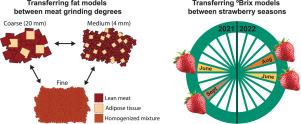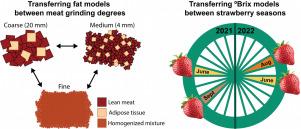拉曼和近红外光谱:通过两个案例研究讨论食品质量测量的校准稳健性
IF 6
2区 化学
Q1 CHEMISTRY, ANALYTICAL
引用次数: 0
摘要
背景:食品质量的快速和无损光谱测量因其在决策支持和流程优化和食品价值链方面的巨大潜力而受到食品行业的极大关注。选择投资的光谱技术类型并不总是直截了当的。在这项工作中,我们讨论了拉曼和近红外光谱的鲁棒性方面作为一个相关的因素来考虑。我们假设拉曼光谱在校准开发和维护方面具有优势,因为光谱中的化学细节程度较高,频带重叠程度较低,对水的灵敏度较低。结果:通过两个案例研究讨论了鲁棒性,评估了(1)完整草莓糖校准在季节之间的可转移性和(2)脂肪模型在不同磨肉程度之间的可转移性。研究表明,拉曼光谱在鲁棒性方面具有固有的化学计量学优势。这在草莓的情况下尤为明显,其中拉曼模型的复杂性(PLSR组件的数量)大约是nir模型的一半,达到了类似的性能,并提供了更多可解释的回归向量。肉类案例表明,该技术的鲁棒性可能取决于对不同样品纹理和异质性的敏感性。直径为3 mm的拉曼探针比直径为6 mm的拉曼探针预测误差更大。我们还展示了拉曼光谱的另一个挑战,即通过延长肉类储存时间来增加荧光。尽管如此,具有6毫米光斑尺寸的拉曼系统优于具有近似1厘米照明光斑的反射几何近红外系统。意义:很少有研究比较拉曼光谱和近红外光谱在食品应用中的差异,集中在鲁棒性方面。这项工作表明,当决定在拉曼光谱和近红外光谱之间或投资哪种类型的采样光学器件时,工业上开发和维护校准的成本应该被考虑到更高的程度,并成为最终成本和实施便利性评估的一部分。这些发现应该促使在长期传感实施之前对这两种技术进行关键的比较。本文章由计算机程序翻译,如有差异,请以英文原文为准。


Raman and NIR spectroscopy: A discussion of calibration robustness for food quality measurements through two case studies
Background:
Fast and nondestructive spectroscopic measurements of food quality are of great interest to the food industry due to their huge potential in decision support and optimization of processes and food value chains. Choosing the type of spectroscopic technique to invest in is not always straight-forward. In this work, we discuss the robustness aspect of Raman and NIR spectroscopy as a relevant factor to consider. We hypothesize that Raman spectroscopy has an advantage in calibration development and maintenance due to the higher degree of chemical details in the spectra, lower degree of band overlap and lower sensitivity to water.
Results:
Robustness was discussed through two case studies, assessing (1) the transferability of intact strawberry sugar calibrations between seasons and (2) the transferability of fat models between different meat grinding degrees. The work indicates that Raman spectroscopy has an inherent chemometric advantage for robustness. This was particularly pronounced in the strawberry case, where Raman models of around half the complexity (number of PLSR components) of NIR-based models reached similar performances and provided more interpretable regression vectors. The meat case demonstrated that the robustness of the techniques may depend on the sensitivity to different sample textures and heterogeneity. A Raman probe with a spot size of 3 mm diameter suffered from higher prediction errors than a probe with 6 mm diameter spot size. We also demonstrated an additional challenge of increasing fluorescence with longer meat storage time for Raman spectroscopy. Still, a Raman system with 6 mm spot size outperformed a reflection geometry NIR system with approximate illumination spot of 1 cm.
Significance:
Few studies that compare Raman and NIR spectroscopy within food applications, focus on the differences regarding robustness. This work shows that the cost of developing and maintaining a calibration industrially should be considered to a higher extent and be part of the evaluation on final cost and implementation ease, when deciding between Raman and NIR spectroscopy or what type of sampling optic to invest in. The findings should motivate critical comparisons of the two techniques prior to long-term sensing implementation.
求助全文
通过发布文献求助,成功后即可免费获取论文全文。
去求助
来源期刊

Analytica Chimica Acta
化学-分析化学
CiteScore
10.40
自引率
6.50%
发文量
1081
审稿时长
38 days
期刊介绍:
Analytica Chimica Acta has an open access mirror journal Analytica Chimica Acta: X, sharing the same aims and scope, editorial team, submission system and rigorous peer review.
Analytica Chimica Acta provides a forum for the rapid publication of original research, and critical, comprehensive reviews dealing with all aspects of fundamental and applied modern analytical chemistry. The journal welcomes the submission of research papers which report studies concerning the development of new and significant analytical methodologies. In determining the suitability of submitted articles for publication, particular scrutiny will be placed on the degree of novelty and impact of the research and the extent to which it adds to the existing body of knowledge in analytical chemistry.
 求助内容:
求助内容: 应助结果提醒方式:
应助结果提醒方式:


